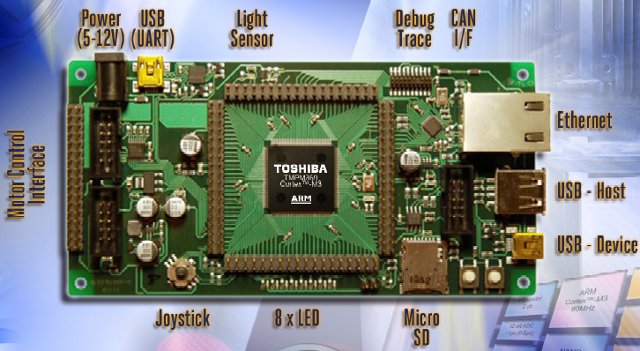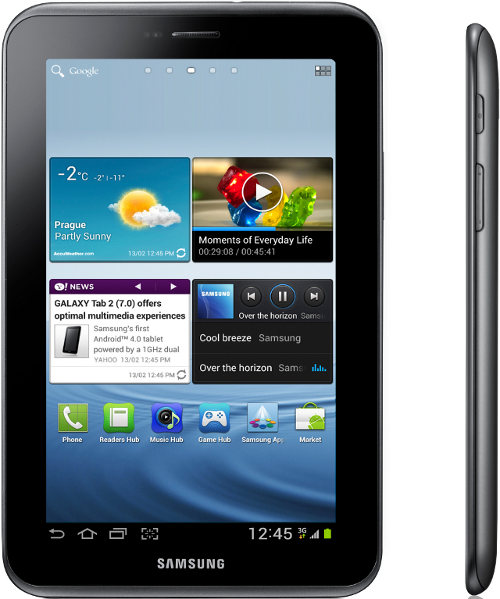Toshiba Electronics will unveil the BMSKTOPASM369, a new Starter Kit for ARM-Cortex M3 microcontrollers at Embedded World 2012. This devkit based on Toshiba TMPM369Fxxx Cortex M3 MCU which combines Ethernet, CAN and USB Host and Device connectivity in a single IC. Toshiba will also showcase new software tools that speed-up and optimize embedded designs for motor control applications. This development board features an integrated power supply and offers rapid prototyping and testing for applications ranging from industrial control systems and barcode readers to motion control, home appliances and solar inverters. The Started Kit is based on TMPM369Fxxx series 32-bit ARM Cortex-M3 MCU running at 80MHz with up to 512KB flash and 128KB RAM. The 4 MCUs in this series also integrate the following: Single-channel CAN2.0B Full-speed USB Host controller Full-speed USB device controller 10/100BASE single-channel Ethernet MAC. 2x 12-bit ADCs suitable forbarcode readers and other applications requiring ultra-fast conversion. 2x […]
MediaTek Announces MT6575 Android Platform
Yesterday, MediaTek Inc. announced the availability of the MT6575, its 3rd generation platform for mid and entry‐level Android smartphones (defined as less than 190 USD wholesale). The MT6575 platform offers a 1GHz ARM Cortex‐A9 processor, a 3G/HSPA modem and runs Android 4.0 (ICS). The company targets 2 market segments with this SoC: mid‐range smartphones – The platform supports 720p HD video playback and recording with an 8MP camera and qHD (960×540) display thanks to a Imagination Technologies PowerVRTM SGX Series5 GPU . Mediatek claims the MT6575 offers over 35% improvement for browser applications and over 20% improvement in graphics capabilities for gaming when compared to competitors’ best offerings in these segments. entry‐level smartphones – The MT6575 also caters to low end smartphone with smaller display sizes, lower resolution, less memory and reduced multimedia requirements. The company claims that the MT6575 has the world’s lowest power consumption, as well as support for […]
Wayland Library: X11 Display Server Replacement for Linux
The X Window System has been implemented in Linux since the beginning and manages the graphical user interface of most Linux distributions, although some embedded systems do without X11 and use lightweight graphics libraries such as Nano-X, SDL, DirectFB etc… X11 is invisible to the end-user but does all the hard work needed to have Gnome, KDE and Unity user interfaces work properly and smoothly. However, in recent years, GNU/Linux desktop graphics has moved from having numerous rendering APIs talking to the X server which manages everything towards putting the Linux kernel in the middle with direct rending (e.g. OpenGL, VDPAU/VAAPI) with window systems taking the backstage. This new architecture provides a much-simplified graphics system offering more flexibility and better performance. The problem is that the X Window System is highly complex, a complexity that is not really needed with the newest version of the kernel. That’s where Wayland protocol comes […]
Samsung Galaxy Tab 2 (7.0) Runs Android 4.0
Samsung has just announced its first Tablet to run Android 4.0 (ICS), the Galaxy Tab 2. The tablet features a dual core 1GHz processor with a 7″ touchscreen display (resolution 1024×600), 1GB RAM and 8, 16 or 32 GB flash expandable via a microSD Slot. There are also front and rear (3MPixel) cameras. Here are Samsung GALAXY Tab 2 (7.0) Product Specifications: Network HSPA+ 21Mbps 850/900/1900/2100 Processor 1 GHz Dual-Core Processor Display 7” WSVGA(1024×600) PLS TFT OS Android 4.0(ICS) Camera Main(Rear): 3 Megapixel Fixed Focus CameraSub(Front): VGA for Video Call Video Codec: MPEG4, H.263, H.264, VC-1, DivX, WMV7, WMV8, VP8Format: 3GP, ASF, AVI, MP4, WMV, FLV, MKV, WebM Playback/ Recording: Full HD@30fps, HD@30fps Audio Codec: MP3, AAC, AC-3, AMR, FLAC, MID, WMA, WAV, VorbisMusic Player with SoundAlive 3.5mm Ear Jack Value-added Features Samsung TouchWiz/ Samsung L!ve Panel UX Samsung Apps Samsung Kies / Samsung Kies air Samsung Hub* – Readers Hub/ […]
Raspberry Pi Linux Distribution: Raspberry Pi Fedora Remix 14
Several operating systems will be able to run on the Raspberry Pi boards. However, the Raspberry Foundation had announced that they were working with Red Hat to deliver a Fedora release optimized for the board and Broadcom BCM2835 processor (ARMv6 + hard-float support). It appears the full name of this distribution is “Raspberry Pi Fedora Remix 14” most probably based on Fedora 14 (as the name implies), and not the latest Fedora 16 release. This Linux distribution will officially be launched on the 22nd of February 2012 at the Seneca Centre for the Development of Open Technology in Toronto, Canada during a 2-hour event (15:00-17:00) featuring: A hands-on opportunity to use a Raspberry Pi Live demonstrations of the Raspberry Pi Fedora Remix software Examples of the educational uses of the Raspberry Pi The 60-computer build farm used to build the Fedora ARM software on which the remix is based Information […]
armStoneA8: 49 Euros ARM Cortex-A8 Single Board Computer
F&S Elektronik Systeme GmbH, a German company, has announced the armStoneA8 , a Single Board Computer (SBC) based on an ARM Cortex A8 that will be available by the first day of the Embedded World 2012 Conference. The great part is that for a limited period (27 February 2012 to 4 March 2012) you’ll be able to buy the board for 49 Euros on their (yet to be launched) online shop. The board, that comes in PicoITX form factor (100 x 72mm), is powered by a Cortex A8 CPU running at 1GHz and the company provides support for Linux, WinCE 6.0 and Windows Embedded Compact 7. The company says the bootloader, SDK, BSP and kernels are already available with support for DirectX, OpenGL and hardware accelerated GStreamer. The company plans to release the detailed specifications before Embedded World 2012, but in the meantime, I found some PDF about the board […]
Embedded World Conference 2012 Schedule
The Embedded World Conference 2012 will taken place on the February 28 – March 1 in Nuremberg, Germany. There will be over 1,000 exhibitors for the tenth conference (it started in 2003) showcasing their new products and solutions for the embedded markets. Beyond the exhibition, there will also be 13 classes and 22 sessions during those 3 days. February 28th 2012 Classes: 09:30 – 15:30 – Modeling Behavior with UML: Interactions and Statecharts by Dr. Bruce Douglass, IBM 16:00 – 17:00 – Agile Systems Engineering by Dr. Bruce Douglass, IBM 09:30 – 18:00 – Introduction to Real-Time Operating Systems by Dr. David Kalinsky, D. Kalinsky Associates 09:30 – 18:00 – Hands-on-Workshop Safety Critical Linux – Automated debugging and code screening with formal methods by Prof. Nicholas Mc Guire, OSADL Safety Critical Linux Working Group and Andreas Platschek, OpenTech. 09:30 – 16:30 – Cryptography and embedded Security – The Workshop chaired […]
Using Your Android Smartphone As A Desktop Computer
I’ve already written some posts with videos showing the many things you could do with your smartphone thanks to MHL Technology. Christian Qantrell (YouTube User) uploaded a video on YouTube where he connected his smartphone to a monitor with a MHL cable showing how it could be used as a desktop computer. I really like his setup with a Samsung Galaxy Nexus (Android 4.0) smartphone connected to a monitor with an MHL adapter (Micro-USB to HDMI) and Apple Bluetooth keyboard and (Magic) trackpad. He also mentioned external power, but this should not be needed if his monitor supported MHL. The Apple trackpad makes it very neat as it tracks the finger movements as it would if you used the smartphone touchscreen. He showed web browsing and music playback and said gmail works great. Thanks to the multi-touch trackpad, pinch and zoom also works. Overall, the user experience feels pretty good. […]











